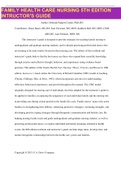Exam (elaborations)
Family Nursing Test Bank.pdf
Author: Deborah Padgett Coehlo, PhD, RN
Contributors: Diane Bauer, MS, RN; Kari Firestone, RN, MSN; Kathleen Bell, RN, MSN, CNM,
AHN-BC; Jane Palmieri, MSN, RN
This instructor’s guide is designed to provide strategies for teaching family nursing to
undergraduate and graduate nursing students,...
[Show more]
Preview 4 out of 332 pages
Uploaded on
March 14, 2022
Number of pages
332
Written in
2021/2022
Type
Exam (elaborations)
Contains
Questions & answers
phd
ms
rn
rn
msn
cnm
msn
rn this instru
family nursing test bankpdf
author deborah padgett coehlo
rn contributors diane bauer
rn kari firestone
msn kathleen bell
ahn bc jane palmieri
All documents for this subject (1)
FAMILY HEALTH CARE NURSING




